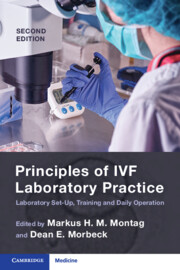Book contents
- Principles of IVF Laboratory Practice
- Principles of IVF Laboratory Practice
- Copyright page
- Contents
- Contributors
- Foreword
- The Evolution of IVF Practice
- Section 1 Starting a New Laboratory and Training Protocols
- Section 2 Pre-procedure Protocols
- Section 3 Gametes
- Chapter 14 Sperm Preparation for Therapeutic IVF
- Chapter 15 Processing Surgically Retrieved Sperm in the IVF Laboratory
- Chapter 16 Cryopreservation of Sperm for IVF
- Chapter 17 Oocyte Collection for IVF
- Chapter 18 In Vitro Maturation of Immature Oocytes for IVM–IVF
- Chapter 19 Oocyte Grading by Morphological Evaluation
- Chapter 20 Vitrification of Oocytes for IVF
- Section 4 Insemination/ICSI
- Section 5 Fertilization Assessment
- Section 6 Embryo Assessment: Morphology and Beyond
- Section 7 Embryo Cryopreservation
- Section 8 Embryo Transfer
- Section 9 Quality Management
- Index
- References
Chapter 18 - In Vitro Maturation of Immature Oocytes for IVM–IVF
from Section 3 - Gametes
Published online by Cambridge University Press: 07 August 2023
- Principles of IVF Laboratory Practice
- Principles of IVF Laboratory Practice
- Copyright page
- Contents
- Contributors
- Foreword
- The Evolution of IVF Practice
- Section 1 Starting a New Laboratory and Training Protocols
- Section 2 Pre-procedure Protocols
- Section 3 Gametes
- Chapter 14 Sperm Preparation for Therapeutic IVF
- Chapter 15 Processing Surgically Retrieved Sperm in the IVF Laboratory
- Chapter 16 Cryopreservation of Sperm for IVF
- Chapter 17 Oocyte Collection for IVF
- Chapter 18 In Vitro Maturation of Immature Oocytes for IVM–IVF
- Chapter 19 Oocyte Grading by Morphological Evaluation
- Chapter 20 Vitrification of Oocytes for IVF
- Section 4 Insemination/ICSI
- Section 5 Fertilization Assessment
- Section 6 Embryo Assessment: Morphology and Beyond
- Section 7 Embryo Cryopreservation
- Section 8 Embryo Transfer
- Section 9 Quality Management
- Index
- References
Summary
Most laboratories use HEPES buffer solution for oocyte retrieval because it provides pH stability through buffering action. In contrast, there are laboratories that use workstations which provide CO₂ and temperature stability during oocyte collection. When this type of workstation is used, HEPES buffer solution is not required. In laboratories working without a dedicated workstation, the recovery and processing of oocytes should be done quickly to maintain optimal oocyte temperature and pH conditions.
- Type
- Chapter
- Information
- Principles of IVF Laboratory PracticeLaboratory Set-Up, Training and Daily Operation, pp. 136 - 143Publisher: Cambridge University PressPrint publication year: 2023



